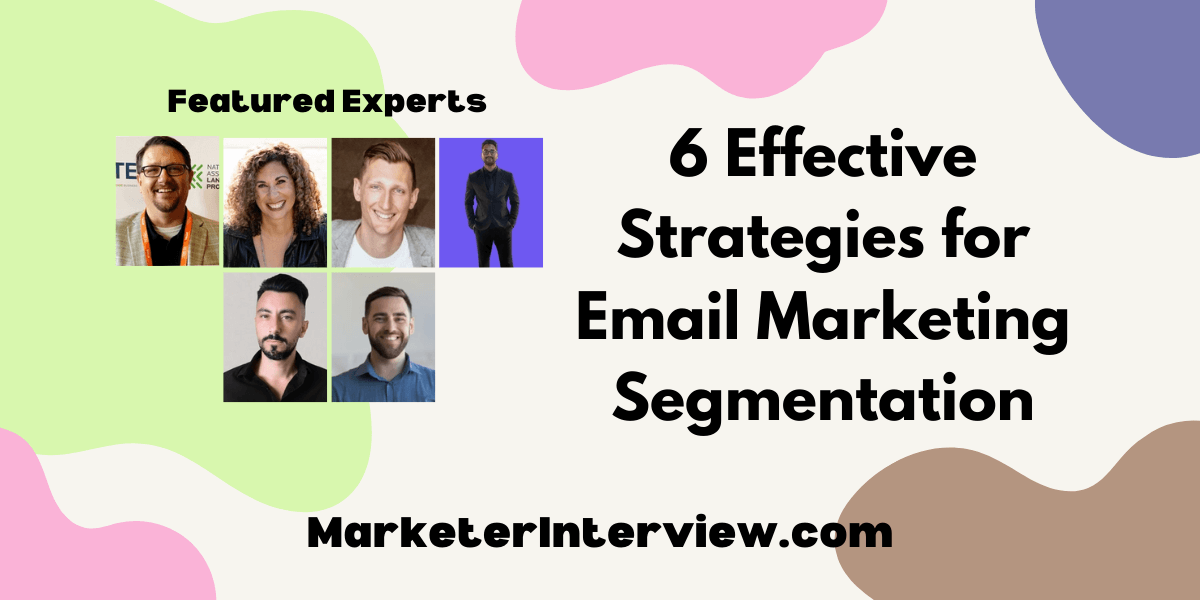6 Effective Strategies for Email Marketing Segmentation
In the ever-evolving realm of email marketing, precise email marketing segmentation is key to reaching the right audience. We’ve gathered six strategies from top marketing professionals, including Growth & Marketing Managers and Heads of Marketing. From utilizing behavioral segmentation to implementing a lifecycle segmentation strategy, discover the specific tactics these experts recommend for effective email marketing segmentation.
Want to get quoted in MarketerInterview.com content just like this? Apply to become a contributor today!
Contents
Utilize Behavioral Email Marketing Segmentation
One specific strategy I use for effective email marketing segmentation is behavioral segmentation. This involves dividing your email list based on the actions or behaviors that subscribers exhibit, such as past purchases, website activity, or engagement with previous emails.
Behavioral segmentation allows you to send highly targeted and relevant content to your subscribers. For instance, if a subscriber has recently purchased a product from your online store, you can send them emails related to that product, like usage tips, accessory recommendations, or care instructions.
I recommend this strategy because it enables you to provide personalized content that resonates with your subscribers’ interests and needs, thereby increasing engagement rates. It also helps in nurturing leads and moving them down the sales funnel more effectively.
Remember, the key to successful segmentation is understanding your audience and their behavior well. So, invest time in analyzing your subscribers’ data and actions.

Swapnil Kumar, Growth & Marketing Manager, Smartlead
Segment by Sales Funnel Stage
A strategy I find highly effective in email marketing is segmenting contacts by their stage in the sales funnel. This means sending different emails to people depending on how familiar they are with your brand. New subscribers get a broad overview, like a welcome series introducing them to what you offer.
For those who’ve been around longer and show interest in specific topics, I send more targeted content about those interests. It’s about giving everyone the right message at the right time, making emails more relevant and engaging.

Marco Genaro Palma, Content Marketing Manager, PRLab
Base Segmenting on Engagement Activity
When a client approaches us with their list for the first time, one of the first segmentation strategies I recommend is engagement-activity segmentation. When a list sees low open or click rates, it can be challenging to gauge what is and isn’t working for the list. What subject line is a top performer? What content drove clicks or purchases?
By segmenting your least and most engaged subscribers, you can run better testing to know what really is an effective campaign, and what might need a bit more adjustment to garner the best results.

MaryAnn Pfeiffer, Principal & Founder, 108 Degrees Digital Marketing
Craft Emails from Website Interactions
Our approach focuses on the specific actions visitors take on our website. By monitoring the pages they visit and the content they interact with, we craft emails that directly speak to their interests. Utilizing tools such as Kissmetrics and Google Analytics, we’re able to gather detailed behavioral data, enabling us to segment our audience with precision.
This method improves the relevance of our emails, leading to higher engagement rates. It’s a targeted strategy that not only increases the effectiveness of our email campaigns but also significantly enhances the user experience by ensuring the content they receive is closely aligned with their preferences and actions on our site.

Tobias Liebsch, Co-Founder, Fintalent.io
Prioritize Open Rates and Purchase History
An effective email marketing segmentation strategy focuses on customer behavior. By analyzing email interactions, such as open rates and purchase history, you can segment subscribers into groups such as highly engaged, inactive, frequent purchasers, or cart abandoners. Tailoring content to each segment’s interests boosts message relevance, engagement, and conversions.
This approach enables sending targeted, personalized emails that resonate with recipients, driving desired actions. By aligning content with segment preferences, overall campaign effectiveness improves, fostering stronger audience relationships. Behavior-based segmentation also highlights opportunities for re-engaging inactive subscribers and upselling to frequent purchasers, maximizing the email list’s value.

Travis Willis, Director of Customer Success, Aspire
Implement a Lifecycle Segmentation Strategy
In my role at CrownTV, one standout strategy for email marketing segmentation revolves around “Lifecycle Segmentation.” Rather than grouping subscribers based on static criteria, this method dynamically adjusts content according to where individuals are in their customer journey.
By sending targeted messages tailored to their stage—whether it’s awareness, consideration, or retention—we optimize engagement and conversion rates. This strategy acknowledges that each subscriber’s needs evolve over time, ensuring our emails remain relevant and impactful throughout their interaction with our brand.

Alex Taylor, Head of Marketing, CrownTV
Want to get quoted in MarketerInterview.com content just like this? Apply to become a contributor today!






